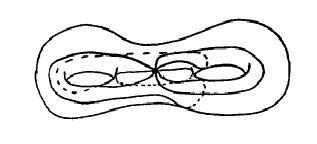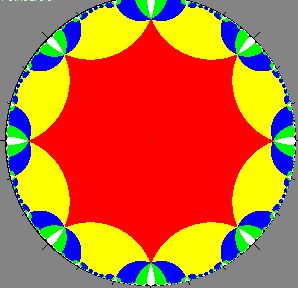
| Here we glue the side with a number on it with the side that has the same number on it. It is an exercise in visualization skills to see that the resulting figure is a 2-holed donut. Here are directions and pictures for sewing the 2-holed donut that may be helpful for visual purposes. |  |
How many triangles are there?______________
What is the total angle sum? Show work ______________
What is the interior angle of a flat octagon? Show work ______________
To understand why the laws of Euclidean geometry that you learned in high school do not apply to the 2-holed donut, we can look to see whether octagons will tile the plane in the same way that Escher created his works of art. So we would like to know whether we can take a certain number of octagons (instead of angels and demons like Escher used in the distorted hyperbolic Heaven and Hell work...) and put them together around a vertex in order to form 360 degrees.
How much of 360 degrees is left over at the red vertex when two octagons are placed side by side like is indicated by the green arc?
 __________________
__________________
What happens if you try and place three octagons together at a vertex? Do they fit into 360 degrees? __________________ If so, we could create a flat tiling work of art (like Escher) without distorting them. If not, then we must distort them in order to create a flat work of art.
We can create a 2-holed donut by using a distorted octagon with bowed-in 45 degree interior angles. Eight of these glue together in a space that looks like Escher's work to form 360 degrees at a vertex and so they tile the space. Now we understand some of the issues that Escher faced. Here is the tiled octagons in the Poincare disk model as well as a crochet model of hyperbolic space with one hyperbolic octagon:

